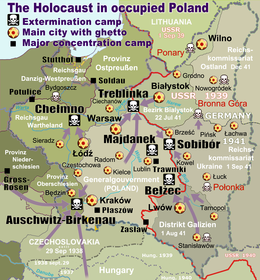Ghetto Siedlce

The Siedlce ghetto was a ghetto established during the German occupation of Poland in Siedlce , in the Warsaw district of the Generalgouvernement . The ghettos at the time of National Socialism were part of the concentration camp system . Siedlce was occupied by the Wehrmacht on October 10, 1939 after the start of the Second World War . Around 15,000 people lived in Siedlce; about half of the population was Jewish .
The Siedlce ghetto was established on November 15, 1939; however, the fenced off residential area was not guarded at the end of 1941. In 1941, Roma who had been deported to the Generalgouvernement in the course of the May deportation in 1940 were detained in a separate building complex . Jews and Roma had in the city and outside labor afford. A second deportation of Roma - from the Siedlce district - to the large ghetto took place in June 1942. Beginning on August 19, 1942, around 10,000 Jews from Siedlce were deported to the Treblinka extermination camp . There were also killings of Roma. The remaining Roma were taken to the small ghetto just outside the city . In September 1942 there were again, as contemporary German sources report, " atrocities " by a German "Sonderkommando" in the district town. During the action Zamość , that the Germanization - or " Umvolkungsversuchs " in the context of the General Plan East , was Siedlce as a "retirement village" accommodation station 350 forced ausgesiedelte families from the district of Lublin , the ethnic Germans had to make room.
Individual evidence
- ↑ deathcamps.org
- ^ Ghetto list ( memento of October 14, 2018 in the Internet Archive ) of the Federal Ministry of Finance , p. 90.
- ↑ VEJ 9/15 In: Klaus-Peter Friedrich (arr.): The persecution and murder of European Jews by Nazi Germany from 1933 to 1945 (source book), Volume 9: Poland: General August 1941-1945. Munich 2013, ISBN 978-3-486-71530-9 , p. 112.
- ↑ Bogdan Musial : German civil administration and the persecution of Jews in the Generalgouvernement. A case study on the Lublin District 1939–1944. (= German Historical Institute Warsaw, sources and studies. Volume 10). Wiesbaden 2004, p. 302.
- ^ Israel Gutman et al. (Ed.): Encyclopedia of the Holocaust . Munich / Zurich 1995, ISBN 3-492-22700-7 , p. 1312.
- ↑ Eyewitness report of the soldier Hubert Poch as document VEJ 9/122 In: Klaus-Peter Friedrich (edit.): The persecution and murder of European Jews ... Volume 9: Poland: Generalgouvernement August 1941–1945. Munich 2013, ISBN 978-3-486-71530-9 , pp. 391f.
- ↑ Unless Musial is specified, applies to this section: Michael Zimmermann: Rassenutopie und Genozid. The National Socialist "Solution to the Gypsy Question". Hamburg 1996, p. 178 f.
- ↑ Bogdan Musial: German civil administration and the persecution of Jews in the Generalgouvernement. A case study on the Lublin District 1939–1944. (= German Historical Institute Warsaw, sources and studies. Volume 10). Wiesbaden 2004, p. 335 f.
- ^ Bruno Wasser: Himmler's spatial planning in the east: The general plan east in Poland 1940-1944. Basel 1994, p. 272.
Coordinates: 52 ° 10 ′ 0 ″ N , 22 ° 18 ′ 0 ″ E

